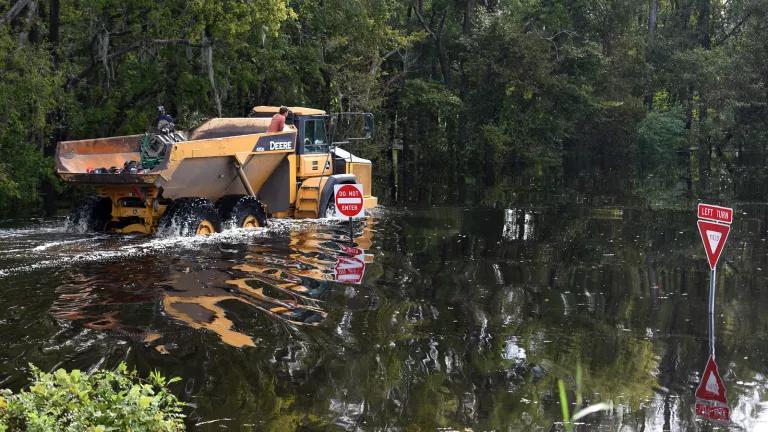Flood Protection Standard One-Year Later
How and where the country’s public hospitals, roads, schools, seaports, and wastewater treatment plants are built must change to account for a warming world.

President Biden reinstated the Federal Flood Risk Management Standard (“the Standard”) one year ago. The Standard – revoked 10 days before Hurricane Harvey by President Trump – requires all federally funded infrastructure to be constructed and located to withstand future flood risks. However, not one federal agency has fully implemented the Standard since its revival.
Flooding has become more common and pervasive due to sea level rise and other effects of climate change. One-hundred twenty-one Major Disaster Declarations for flooding and hurricanes have been issued since 2017. Tens of billions of dollars have been spent rebuilding. Full implementation of the Standard by all federal agencies involved in disaster recovery would ensure we do not simply rebuild to the status quo.
Further, as money starts flowing from the Infrastructure Investment and Jobs Act, there is the potential major infrastructure projects, like new highways or rail corridors, will be built without consideration of the Standard. This omission potentially sets such projects up for failure as sea levels rise and heavy rainstorms become more frequent.
Federal agencies must act quickly and fully incorporate the Standard into their infrastructure funding programs both for public infrastructure rebuilt after a storm and new infrastructure yet to be built. The impacts of climate change will not wait.
The standard and future flood risk
The Standard acknowledges that building to the climate of the past is no longer tenable. The Standard directs federal agencies to use more protective siting and design requirements for infrastructure projects that receive federal funding, such as affordable housing, emergency response facilities, and water and wastewater systems. Projects are required to be located outside of low-lying areas vulnerable to flooding whenever practicable, or, when not practicable, they are required to be more resilient against future flood conditions, including the impacts of sea level rise.
Full implementation of the Standard will better protect people and property and will ease the federal government’s growing financial exposure by ensuring federally financed infrastructure is better prepared for and adapted to flooding exacerbated by climate change.
Agency action
The White House established an interagency working group to coordinate implementation of the Standard by all Federal agencies. However, only the Federal Emergency Management Agency (FEMA) has acted, and only partially.
FEMA requires any non-critical infrastructure project funded by one of the agency’s Hazard Mitigation Assistance (HMA) programs to be flood-safe a minimum of two-feet above the height of a 100-year flood. Under existing FEMA regulations, critical infrastructure is required to be protected to the level of a 500-year flood event when using funds from these same HMA programs.
FEMA’s announcement presages broad safety and cost-savings implications for how the nation prepares for major disasters. The HMA programs, which include the Building Resilient Infrastructure and Communities (BRIC) program, the Flood Mitigation Assistance (FMA) program, and the Hazard Mitigation Grant Program (HMGP), are projected to spend billions of dollars in the coming years, better preparing the United States for a more risky future due to climate change. In FY2021, the BRIC and FMA programs will make available nearly $1.2 billion. Concerning the HMGP, the Biden administration announced $3.5 billion in eligible funding, which represents close to 25 percent of all funding ever allocated through the program.
This $4.7 billion investment will likely translate to major infrastructure investments. The reinstated Standard will ensure those investments are designed for a future of more extreme flooding, better protecting the Americans who will rely on those investments to keep them safe.
However, FEMA’s HMA programs represent only a small portion of the money the federal government spends on infrastructure development. FEMA’s Public Assistance program has shelled out billions of dollars helping communities recover from major disaster events. The Department of Homeland Security’s Inspector General recently faulted FEMA for repeatedly paying to repair infrastructure that was damaged by flooding. Full implementation of the Standard across all FEMA programs would ensure these assets are rebuilt to a higher margin of safety, lessening the chance of the being damaged again.
However, other Federal agencies, such as the Department of Housing and Urban Development (HUD), the Department of Transportation (DOT), the Environmental Protection Agency (EPA), and the US Army Corps of Engineers (USACE), have taken no public action. These agencies are significant funders of public infrastructure.
IIJA implementation
Additionally, the majority are set to receive hundreds of billions of dollars from the Infrastructure Investment and Jobs Act (IIJA) to construct major public works. For example, EPA received nearly $24 billion for their Clean and Drinking Water State Revolving Loan Funds. DOT received nearly $150 billion just for the National Highway Performance Program (NHPP), which provides for the construction of new facilities. USACE received nearly $10 billion for water infrastructure projects.
While not all projects will be at risk of severe flooding, some will be and should be subject to the application of the Standard. Heavier rains, intensifying coastal storms, and rising seas—the impacts of climate change—are exacerbating the risk of flooding across the United States. IIJA funded projects should not be built without accounting for such impacts. Communities already struggle to maintain aged and deteriorating infrastructure. New infrastructure built absent climate consideration only sets these communities up for the same issues.
More action needed
As the climate changes, major flooding events will happen with greater frequency, significant flood losses in areas outside the identified 100-year floodplain will occur more often, and the federal share of disaster recovery costs will continue to grow. How and where the country’s public hospitals, roads, schools, seaports, and wastewater treatment plants are built must change to account for a warming world. Building such infrastructure is expensive. It should last as long as intended. Implementation of the Standard will help ensure that it does last.




